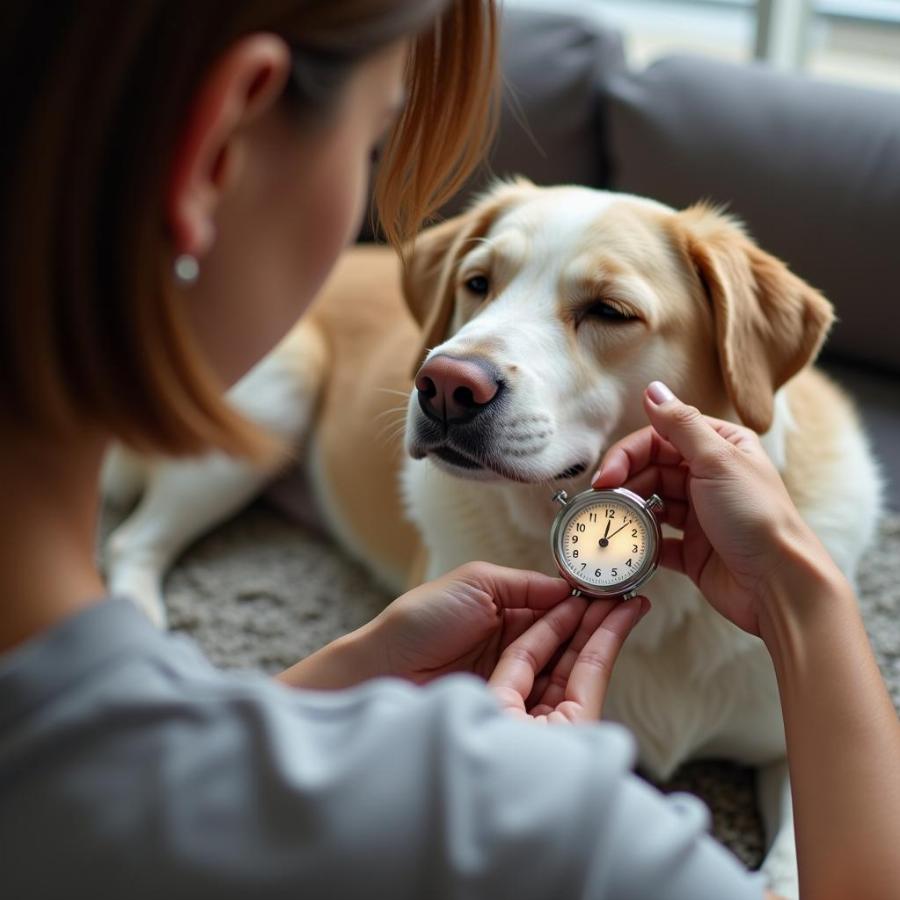Understanding your dog’s resting respiration rate (RRR) is a crucial aspect of responsible pet ownership. It can provide valuable insights into their overall health and well-being, allowing you to detect potential issues early on. This guide will delve into the details of what a normal RRR looks like, how to measure it accurately, and when variations might signal a cause for concern.
What is a Normal Resting Respiration Rate in Dogs?
A dog’s resting respiration rate refers to the number of breaths they take per minute while relaxed and at rest. A normal RRR for dogs typically falls between 10 and 30 breaths per minute. However, factors like breed, size, age, and even the surrounding temperature can influence this number. Puppies, for example, tend to breathe faster than adult dogs. Similarly, smaller breeds often have a higher RRR compared to larger breeds.
How to Measure Your Dog’s Resting Respiration Rate
Accurately measuring your dog’s RRR is simpler than you might think. Find a quiet, comfortable spot where your dog can relax. While they are lying down or sitting calmly, observe their chest movements. One rise and fall of the chest counts as one breath. Count the number of breaths within a 15-second timeframe and multiply that number by four to get the breaths per minute. Try not to let your dog know you’re observing them, as this can sometimes alter their breathing pattern.
 Measuring a dog's resting respiration rate
Measuring a dog's resting respiration rate
Factors Influencing Resting Respiration Rate
Several factors can cause a dog’s RRR to fluctuate within the normal range. Exercise, excitement, stress, and heat can all temporarily increase breathing rate. These changes are usually short-lived and resolve once the dog returns to a calm state. For instance, after a vigorous playtime at the park, you’ll likely notice your dog panting heavily, which is a normal way for them to cool down.
When to Worry About Your Dog’s Breathing
While some variation in RRR is expected, certain signs warrant closer attention. Rapid breathing, labored breathing, excessive panting, bluish gums, or weakness can indicate underlying health problems. If your dog is exhibiting any of these symptoms, especially alongside changes in behavior or appetite, it’s essential to consult a veterinarian immediately.
Common Causes of Abnormal Resting Respiration Rate
Several conditions can contribute to an abnormal RRR in dogs. Respiratory infections, heart disease, anemia, pain, and heatstroke are among the possible causes. Dr. Emily Carter, a renowned veterinary specialist, emphasizes, “Early detection is key when it comes to respiratory issues in dogs. Monitoring their RRR can help pet owners identify potential problems before they escalate.”
What if My Dog’s Resting Respiration Rate is Too High?
An elevated RRR, also known as tachypnea, can be triggered by anxiety, pain, fever, or respiratory issues. If your dog’s RRR consistently exceeds the normal range, seek veterinary advice. Prompt diagnosis and treatment are vital for a positive outcome.
What if My Dog’s Resting Respiration Rate is Too Low?
While less common, a significantly low RRR can also be concerning. This can be a sign of hypothermia, certain medications, or neurological problems. Consult your veterinarian if you notice your dog’s breathing rate is unusually slow.
Conclusion
Monitoring your dog’s resting respiration rate is a valuable tool for assessing their health. Understanding what’s normal for your dog and recognizing potential warning signs can help you ensure their well-being. While minor fluctuations are often harmless, significant changes in RRR warrant prompt veterinary attention. Remember, early detection is crucial for effective treatment and a happy, healthy life for your canine companion.
FAQs about Resting Respiration Rate in Dogs
- How can I tell if my dog is breathing normally? Observe their chest movements while they’re at rest. Count the breaths in 15 seconds and multiply by four. A normal RRR typically falls between 10 and 30 breaths per minute.
- What should I do if my dog’s breathing is fast? If accompanied by other symptoms like panting, bluish gums, or weakness, consult a veterinarian immediately.
- Can stress affect a dog’s breathing? Yes, stress and anxiety can temporarily increase a dog’s breathing rate.
- Is it normal for a puppy to breathe faster than an adult dog? Yes, puppies generally have a higher RRR than adult dogs.
- Does breed affect resting respiration rate? Yes, smaller breeds often have a higher RRR than larger breeds.
- How often should I check my dog’s resting respiration rate? Regularly monitoring your dog’s RRR, especially if they have underlying health conditions, is a good practice.
- What are some signs of labored breathing in dogs? Visible chest contractions, open-mouth panting, and distressed behavior can indicate labored breathing.
Find More Helpful Information on Beaut Dogs:
Beaut Dogs is your ultimate resource for all things related to dog care. We offer expert advice, breed information, and helpful tips to ensure your furry friend thrives. When you need support, contact us at Email: [email protected] for detailed and accurate answers from Beaut Dogs.